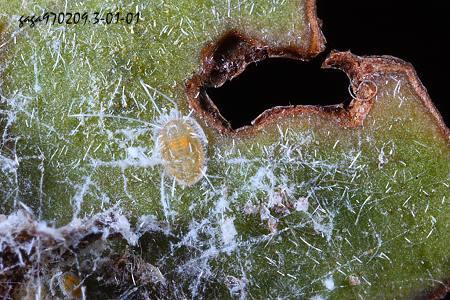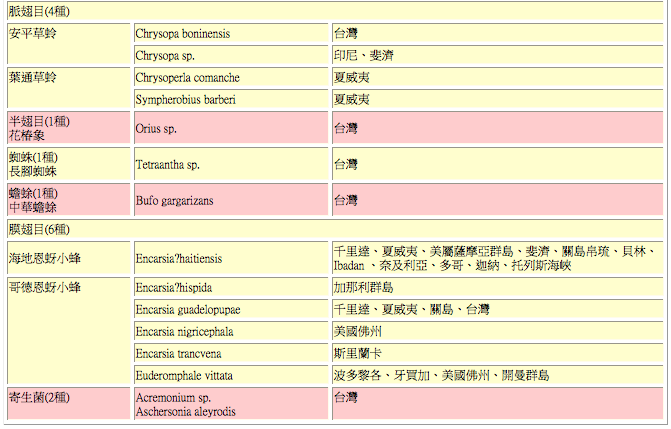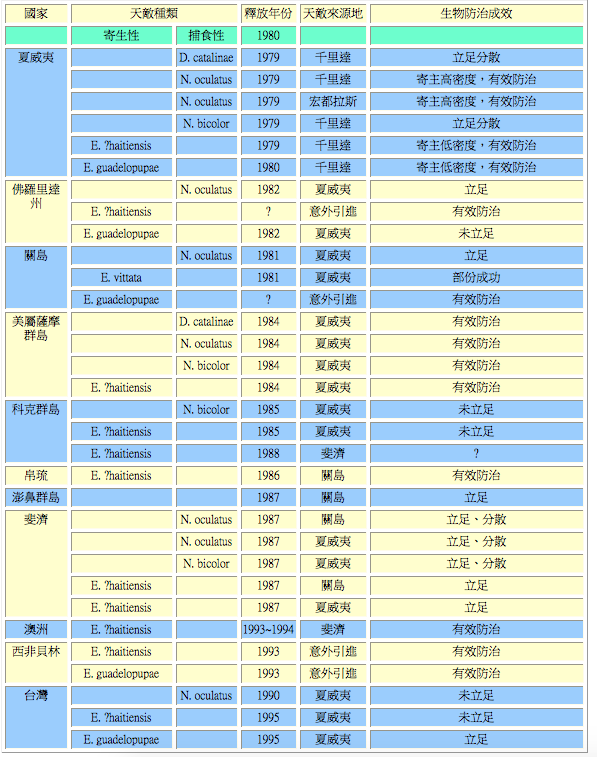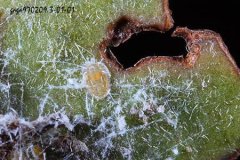Whitefly control: spiral whitefly control, how to control spiral whitefly?
There are two methods to control whitefly, one is physical control, the other is biological control. What are the natural enemies of spiral whitefly? Let's take a look.

1. Physical prevention and cure
The leaf back of guava was treated every 2 days at a water rate of 12.5 liters per minute in the field. After 4 weeks of continuous treatment, the results showed that the control rates of adult and nymph of spiral whitefly were 86% and 79% respectively.
two。 Biological control
A total of 49 species of natural enemies of spiral whitefly were recorded, including 41 species of predatory natural enemies and 8 species of parasitic natural enemies (Table 1), but there were only three species of lady beetles (Delphastus catalinae, Nephaspis oculatus and Nephaspis bicolor) and three species of parasitic wasps (Encarsia haitiensis, Encarsia guadelopupae and Euderomphale vittata).
Whitefly whitefly is an omnivorous pest of vegetables, fruit trees, grain, ornamental plants, street trees and forests. Although chemical control and physical control can achieve the effective control of the pest, because of its extensive and sporadic hosts and the effectiveness of biological control in the world, biological control has become the most suitable method for the control of whitefly. Although the biological control of spiral whitefly in Taiwan has propagated in large numbers and released its parasitoids (57032 and 66929 respectively), it has no significant effect on controlling spiral whitefly. It may be that the aphid wasp in Hawaii, Pacific Islands, Torres Strait of Australia and Beilin in West Africa can rapidly gain a foothold and disperse by releasing a small amount (40,120) or accidentally introduced. But the bee cannot gain a foothold in Florida and Taiwan. In addition, Hawaii, the Pacific Islands, the Strait of Torres in Australia and Beilin in West Africa emphasized the inhibitory effect of aphid wasps on spiral whitefly, however, there should be other important biological and abiotic factors besides parasitic wasps in Hawaii and Beilin, West Africa. However, the population density of spiral whitefly in Taiwan mainly shows seasonal fluctuation, and the effect of Gothenne aphid wasp is not significant.
In addition, through the author's field investigation from 1997 to 1999, it was found that there were four reasons for the parasitic release or foothold of spiral whitefly in Taiwan.
1. The habitat environment is unstable.
When host plants are of no economic importance, such as roadside olive kernels, Wicker's amaranth and Christmas red, they are heavily pruned and cut down. On the other hand, when the host plant is economically important, such as guava, chemical control is applied once it harms farmers, while in Taiwan, the preferred host plant, such as olive kernel, has the habit of deciduous leaves in late winter and early spring. as a result, it is difficult to cooperate with the homology of host and parasitoids.
two。 The occurrence period of spiral whitefly is in autumn, and the age of whitefly is quite consistent.
Due to the sudden surge of snail population density in autumn, it is difficult to see the effect of parasitic wasps released by general inoculation. However, if the parasitic wasp is released in the form of overflow, it is also limited by the reproductive cost of parasitic wasps and the characteristics of host omnivorous, so it is not easy to implement.
3. Meiyu and typhoon.
The release of parasitic wasps of spiral whitefly was affected not only by the density of spiral whitefly, but also by Meiyu in May and June and typhoon from July to September.
4. The high temperature in summer is not suitable for the survival of the aphid wasp.
Field investigation showed that only one month after the parasitoid was released in 1996 and December 1997, the aphid pupae were recovered in Zengwen Reservoir, Chiayi Institute of Technology and Agricultural Experimental Institute, and then there was no trace of them. For example, the fecundity of Haitian aphid wasp and Gothenne aphid wasp is only 3 and 2 eggs respectively at 15 degrees, 158 and 108 eggs at 20 degrees 25 degrees and 16 and 118 eggs at 30 degrees respectively (Qian Jingqin and Zhang Shuzhen, unpublished data), while the winter temperature in central and southern Taiwan will occasionally drop below 15 degrees unless a cold spell strikes, but the daytime temperature in summer is often more than 30 degrees higher. Therefore, it is inferred that the high temperature in summer may be the main reason why the bee can not gain a foothold in Taiwan. However, whether this argument is consistent with the performance of Haitian aphid wasps in other regions remains to be discussed.
Table 1. Natural enemies of spiral whitefly


Table 2. Biological control of spiral whitefly in the world

- Prev

What are the types of whitefly, whitefly and whitefly?
Whitefly spiralis is a new invasive pest in Hainan Province, which has the characteristics of multiple modes of transmission, multiple host species and rapid reproduction. Then its morphology and life history and harm, you want to know about it, this is a good help to control spiraling whitefly. twist
- Next

Pesticide detection methods in vegetables: how to detect pesticide residues in vegetables?
Pesticides are difficult to wash off completely with water, especially water-soluble pesticides will be absorbed by plants from the roots and enter the plant body, which cannot be washed at all, while fat-soluble pesticides are insoluble in water and are difficult to wash with water. using fruit and vegetable cleaners is in danger of secondary pollution.
Related
- A one-day flower show brings 130 million yuan in orders! Nanhai, this Phalaenopsis exhibition is amazing
- What do the flower language and meaning of Lutheran tree mean? Precautions for planting Lutheran tree
- Encounter Chaoshan Kongfu tea, not without this cup of Phoenix single clump
- The durian market in Vietnam and Thailand is flooded. The price of imported durian has plummeted by 30-40% in a month.
- Shanghai solved the problem of local vegetable supply by planting 80,000 mu of green leafy vegetables.
- Wageningen University has become the best agricultural university in the world for the seventh time in a row.
- The strongest export season of South African grapes is full of challenges, with exports to Russia falling sharply by 21%.
- Sri Lanka is on the verge of bankruptcy, "Tea for debt" Organic Agriculture Revolution aggravates the Food crisis?
- Turning waste into earthworm manure and worm manure into organic fertilizer-A new choice for auxiliary farming
- Organic rice growers shoulder the responsibility of nurturing agricultural talents! Yinchuan Sustainable Farm with Organic Life Camp

